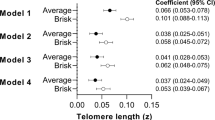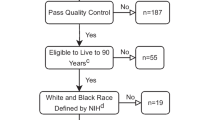Abstract
Leukocyte telomere length (LTL) is known to be associated with mortality, but its association with age-related decline in physical functioning and the development of disability is less clear. This study examined the associations between LTL and physical functioning, and investigated whether LTL predicts level of physical functioning over an 11-year follow-up. Older mono- (MZ) and dizygotic (DZ) twin sisters (n = 386) participated in the study. Relative LTL was measured by qPCR at baseline. Physical functioning was measured by 6-min walking distance and level of physical activity (PA). Walking distance was measured at baseline and at 3-year follow-up. PA was assessed by questionnaire at baseline and at 3- and 11-year follow-ups. The baseline analysis was performed with path models, adjusted with age and within-pair dependence of twin pairs. The longitudinal analysis was performed with a repeated measures linear model adjusted for age and longitudinal within-pair dependence. A nonrandom missing data analysis was utilized. At baseline, in all individuals, LTL was associated with PA (est. 0.14, SE 0.06, p = 0.011), but not with walking distance. Over the follow-up, a borderline significant association was observed between LTL and walking distance (est. 0.14, SE 0.07, p = 0.060) and a significant association between LTL and PA (est. 0.19, SE 0.06, p = 0.001). The results suggest that LTL is associated with PA and may, therefore, serve as a biomarker predicting the development of disability. Longitudinal associations between LTL and PA were observed only when nonrandom data missingness was taken into account in the analysis.

Similar content being viewed by others
References
Ahola K, Siren I, Kivimaki M, Ripatti S, Aromaa A, Lonnqvist J, Hovatta I (2012) Work-related exhaustion and telomere length: a population-based study. PLoS One 7:e40186. doi:10.1371/journal.pone.0040186; 10.1371/journal.pone.0040186.
Albrecht E, Sillanpaa E, Karrasch S, Alves AC, Codd V, Hovatta I, Buxton JL, Nelson CP, Broer L, Hagg S, et al. (2014) Telomere length in circulating leukocytes is associated with lung function and disease. Eur Respir J 43:983–992. doi:10.1183/09031936.00046213
Andrew T, Aviv A, Falchi M, Surdulescu GL, Gardner JP, Lu X, Kimura M, Kato BS, Valdes AM, Spector TD (2006) Mapping genetic loci that determine leukocyte telomere length in a large sample of unselected female sibling pairs. Am J Hum Genet 78:480–486
ATS Committee on Proficiency Standards for Clinical Pulmonary Function Laboratories (2002) ATS statement: guidelines for the six-minute walk test. Am J Respir Crit Care Med 166:111–117. doi:10.1164/ajrccm.166.1.at1102
Bean JF, Leveille SG, Kiely DK, Bandinelli S, Guralnik JM, Ferrucci L (2003) A comparison of leg power and leg strength within the InCHIANTI study: which influences mobility more? J Gerontol A Biol Sci Med Sci 58:728–733
Bendix L, Gade MM, Staun PW, Kimura M, Jeune B, Hjelmborg JV, Aviv A, Christensen K (2011) Leukocyte telomere length and physical ability among Danish twins age 70+. Mech Ageing Dev 132:568–572. doi:10.1016/j.mad.2011.10.003; 10.1016/j.mad.2011.10.003.
Bischoff C, Graakjaer J, Petersen HC, Hjelmborg J, Vaupel JW, Bohr V, Koelvraa S, Christensen K (2005) The heritability of telomere length among the elderly and oldest-old. Twin Res Hum Genet 8:433–439. doi:10.1375/183242705774310141
Blackburn EH (2005) Telomerase and Cancer: Kirk A. Landon–AACR prize for basic cancer research lecture. Mol Cancer Res 3:477–482
Broer L, Codd V, Nyholt DR, Deelen J, Mangino M, Willemsen G, Albrecht E, Amin N, Beekman M, de Geus EJ, et al. (2013) Meta-analysis of telomere length in 19,713 subjects reveals high heritability, stronger maternal inheritance and a paternal age effect. Eur J Hum Genet 21:1163–1168. doi:10.1038/ejhg.2012.303
Cassidy A, De Vivo I, Liu Y, Han J, Prescott J, Hunter DJ, Rimm EB (2010) Associations between diet, lifestyle factors, and telomere length in women. Am J Clin Nutr 91:1273–1280. doi:10.3945/ajcn.2009.28947
Cawthon RM, Smith KR, O'Brien E, Sivatchenko A, Kerber RA (2003) Association between telomere length in blood and mortality in people aged 60 years or older. Lancet 361:393–395. doi:10.1016/S0140-6736(03)12384-7
Cherkas LF, Hunkin JL, Kato BS, Richards JB, Gardner JP, Surdulescu GL, Kimura M, Lu X, Spector TD, Aviv A (2008) The association between physical activity in leisure time and leukocyte telomere length. Arch Intern Med 168:154–158. doi:10.1001/archinternmed.2007.39
Enders CK (2010) Applied missing data analysis. Guilford Press, New York
Enders C (2011) Missing not at random models for latent growth curve analyses. Psychol Methods 16:1–16. doi:10.1037/a0022640
Enright PL (2003) The six-minute walk test. Respir Care 48:783–785
Folstein MF, Folstein SE, McHugh PR (1975) “Mini-mental state”: a practical method for grading the cognitive state of patients for the clinician. J Psychiatr Res 12:189–198. doi:10.1016/0022-3956(75)90026-6
Gardner MP, Martin-Ruiz C, Cooper R, Hardy R, Sayer AA, Cooper C, Deary IJ, Gallacher J, Harris SE, Shiels PG, et al. (2013) Telomere length and physical performance at older ages: an individual participant meta-analysis. PLoS One 8:e69526. doi:10.1371/journal.pone.0069526
Grimby G (1986) Physical activity and muscle training in the elderly. Acta Med Scand Suppl 711:233–237
Hardy SE, Allore H, Studenski SA (2009) Missing data: a special challenge in aging research. J Am Geriatr Soc 57:722–729. doi:10.1111/j.1532-5415.2008.02168.x
Harris SE, Deary IJ, MacIntyre A, Lamb KJ, Radhakrishnan K, Starr JM, Whalley LJ, Shiels PG (2006a) The association between telomere length, physical health, cognitive ageing, and mortality in non-demented older people. Neurosci Lett 406:260–264
Harris SE, Deary IJ, MacIntyre A, Lamb KJ, Radhakrishnan K, Starr JM, Whalley LJ, Shiels PG (2006b) The association between telomere length, physical health, cognitive ageing, and mortality in non-demented older people. Neurosci Lett 406:260–264
Haycock PC, Heydon EE, Kaptoge S, Butterworth AS, Thompson A, Willeit P (2014) Leucocyte telomere length and risk of cardiovascular disease: systematic review and meta-analysis. BMJ 349:g4227. doi:10.1136/bmj.g4227
Hjelmborg JB, Dalgard C, Moller S, Steenstrup T, Kimura M, Christensen K, Kyvik KO, Aviv A (2015) The heritability of leucocyte telomere length dynamics. J Med Genet 52:297–302. doi:10.1136/jmedgenet-2014-102736
Kaprio J, Koskenvuo M (2002) Genetic and environmental factors in complex diseases: the older Finnish Twin Cohort. Twin Res 5:358–365. doi:10.1375/136905202320906093
Kaprio J, Sarna S, Koskenvuo M, Rantasalo I (1978) The Finnish Twin Registry: formation and compilation, questionnaire study, zygosity determination procedures, and research program. Prog Clin Biol Res 24 Pt B:179–184.
Kimura M, Hjelmborg JV, Gardner JP, Bathum L, Brimacombe M, Lu X, Christiansen L, Vaupel JW, Aviv A, Christensen K (2008) Telomere length and mortality: a study of leukocytes in elderly Danish twins. Am J Epidemiol 167:799–806. doi:10.1093/aje/kwm380; 10.1093/aje/kwm380.
Lee JY, Bang HW, Ko JH, Kim JH, Lee DC (2013) Leukocyte telomere length is independently associated with gait speed in elderly women. Maturitas 75:165–169. doi:10.1016/j.maturitas.2013.03.008
Ludlow AT, Zimmerman JB, Witkowski S, Hearn JW, Hatfield BD, Roth SM (2008) Relationship between physical activity level, telomere length, and telomerase activity. Med Sci Sports Exerc 40:1764–1771. doi:10.1249/MSS.0b013e31817c92aa
Mather KA, Jorm AF, Parslow RA, Christensen H (2011) Is telomere length a biomarker of aging? A review. J Gerontol A Biol Sci Med Sci 66:202–213. doi:10.1093/gerona/glq180
Mundstock E, Zatti H, Louzada FM, Oliveira SG, Guma FT, Parisi MM, Rueda AB, Machado DG, Stein RT, Jones MH, et al. (2015) Effects of physical activity in telomere length: systematic review and meta-analysis. Ageing Res Rev 22:72–80
Muthén LK, Muthén BO (1998-2012) Mplus User's Guide. Los Angeles, CA, Muthén & Muthén
Newman AB, Simonsick EM, Naydeck BL, Boudreau RM, Kritchevsky SB, Nevitt MC, Pahor M, Satterfield S, Brach JS, Studenski SA, et al. (2006) Association of long-distance corridor walk performance with mortality, cardiovascular disease, mobility limitation, and disability. JAMA 295:2018–2026
Njajou OT, Hsueh WC, Blackburn EH, Newman AB, Wu SH, Li R, Simonsick EM, Harris TM, Cummings SR, Cawthon RM, et al. (2009) Association between telomere length, specific causes of death, and years of healthy life in health, aging, and body composition, a population-based cohort study. J Gerontol A Biol Sci Med Sci 64:860–864. doi:10.1093/gerona/glp061
Ortega-Alonso A, Pedersen NL, Kujala UM, Sipilä S, Törmäkangas T, Kaprio J, Koskenvuo M, Rantanen T (2006) A twin study on the heritability of walking ability among older women. J Gerontol Ser A Biol Med Sci 61:1082–1085
Pajala S, Era P, Koskenvuo M, Kaprio J, Alen M, Tolvanen A, Tiainen K, Rantanen T (2005) Contribution of genetic and environmental factors to individual differences in maximal walking speed with and without second task in older women. J Gerontol A Biol Sci Med Sci 60:1299–1303
Radloff LS (1977) The CES-D Scale: a self-report depression scale for research in the general population. Appl Psychol Meas 1:385–401. doi:10.1177/014662167700100306
Rantakokko M, Manty M, Rantanen T (2013) Mobility decline in old age. Exerc Sport Sci Rev 41:19–25. doi:10.1097/JES.0b013e3182556f1e
Sarna S, Kaprio J, Sistonen P, Koskenvuo M (1978) Diagnosis of twin zygosity by mailed questionnaire. Hum Hered 28:241–254
Tiainen K, Pajala S, Sipila S, Kaprio J, Koskenvuo M, Alen M, Heikkinen E, Tolvanen A, Rantanen T (2007) Genetic effects in common on maximal walking speed and muscle performance in older women. Scand J Med Sci Sports 17:274–280. doi:10.1111/j.1600-0838.2006.00553.x
Tiainen K, Sipila S, Alen M, Heikkinen E, Kaprio J, Koskenvuo M, Tolvanen A, Pajala S, Rantanen T (2004) Heritability of maximal isometric muscle strength in older female twins. J Appl Physiol 96:173–180. doi:10.1152/japplphysiol.00200.2003
Vasa-Nicotera M, Brouilette S, Mangino M, Thompson JR, Braund P, Clemitson JR, Mason A, Bodycote CL, Raleigh SM, Louis E, et al. (2005) Mapping of a major locus that determines telomere length in humans. Am J Hum Genet 76:147–151
von Zglinicki T, Martin-Ruiz CM (2005) Telomeres as biomarkers for ageing and age-related diseases. Curr Mol Med 5:197–203
Weischer M, Bojesen SE, Nordestgaard BG (2014) Telomere shortening unrelated to smoking, body weight, physical activity, and alcohol intake: 4,576 general population individuals with repeat measurements 10 years apart. PLoS Genet 10:e1004191. doi:10.1371/journal.pgen.1004191
Willeit P, Raschenberger J, Heydon EE, Tsimikas S, Haun M, Mayr A, Weger S, Witztum JL, Butterworth AS, Willeit J, et al. (2014) Leucocyte telomere length and risk of type 2 diabetes mellitus: new prospective cohort study and literature-based meta-analysis. PLoS One 9:e112483. doi:10.1371/journal.pone.0112483
Zhang WG, Zhu SY, Bai XJ, Zhao DL, Jian SM, Li J, Li ZX, Fu B, Cai GY, Sun XF, et al. (2014) Select aging biomarkers based on telomere length and chronological age to build a biological age equation. Age (Dordr) 36:9639. doi:10.1007/s11357-014-9639-y
Zhao J, Miao K, Wang H, Ding H, Wang DW (2013) Association between telomere length and type 2 diabetes mellitus: a meta-analysis. PLoS One 8:e79993. doi:10.1371/journal.pone.0079993
Acknowledgments
The authors acknowledge Dr. Iiris Hovatta and Ms. Jenni Lahtinen for their help in carrying out the telomere length analysis by qPCR. The Gerontology Research Center is a joint effort between the University of Jyväskylä and the University of Tampere. The Finnish Twin Study of Aging (FITSA) was funded by the Ministry of Education, Academy of Finland, and the EC FP5 GenomEUtwin project (grant numbers 213506 and 129680). E.S. and T.T. are supported by post doc research grants from the Academy of Finland (grant numbers 260001 and 286536). J.K. has been supported by the Academy of Finland (grants 265240 and 263278).
Author information
Authors and Affiliations
Corresponding author
Ethics declarations
The study protocol has been approved by the Ethics Committee of the Central Hospital District of Central Finland (K-S shp: Dnro 24/2000)
About this article
Cite this article
Sillanpää, E., Törmäkangas, T., Rantanen, T. et al. Does telomere length predict decline in physical functioning in older twin sisters during an 11-year follow-up?. AGE 38, 34 (2016). https://doi.org/10.1007/s11357-016-9898-x
Received:
Accepted:
Published:
DOI: https://doi.org/10.1007/s11357-016-9898-x




